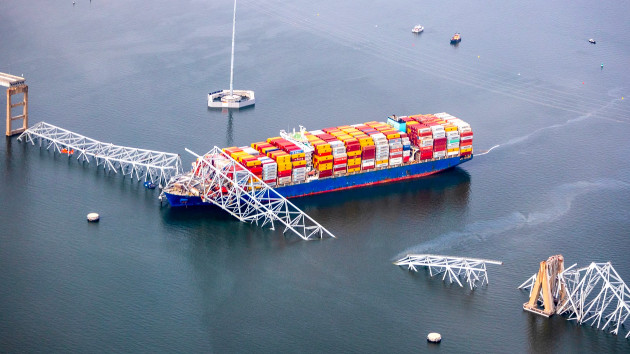(BALTIMORE) — Baltimore’s Key Bridge, a vital transit and shipping route, collapsed last month after being hit by a cargo ship. The incident has left members of the community fearing for their future.
Following the deadly bridge collapse, the Port of Baltimore suspended operations, resulting in 8,000 job losses. Many dockworkers have not been paid for weeks and are waiting for cargo ships to resume operations so they can start working again.
Some are still working at nearby smaller ports or on the little cargo that remains in Baltimore from before the bridge collapsed. But that’s nothing in comparison to the flurry of activity this port once was.
The urgency of the situation is reflected in crews working tirelessly to remove the debris and restore Baltimore’s port. However, this is a perilous task that demands immense effort. Commander Bill McKinstry from the U.S. Coast Guard informed ABC News that the divers are grappling with poor visibility due to the water conditions, with only about a foot of visibility.
The enormity of the task ahead for the U.S. Coast Guard and other teams is evident when you consider that the Francis Scott Key Bridge, which was once a crucial transportation link, now lies in the Baltimore Harbor as a massive block of steel and concrete. As a result, most of the harbor is inaccessible to the outside world.
The Army Corps of Engineers is setting an ambitious goal of clearing a channel for smaller cargo ships by late April and reopening the entire port by the end of May.
The port’s absence has plunged the dockworkers, who have been the backbone of their families for years, into a state of uncertainty. They are grappling with the question of how long they can hold on before seeking alternative employment.
Richard Krueger, president of Local 953, said this situation is a crisis and it’s the fear of the unknown.
“We don’t know how long they are going to be off,” Krueger said. How long is it going to take them to open the channel? How long do they have to get through this because they have to pay the bills? And nobody knows. And the truth is we don’t know, we don’t know, we don’t know when the channel is going to be open.”
The crisis affects not only dockworkers but also residents and workers on the waterfront, leaving them uncertain about meeting basic needs such as food, mortgage and rent payments, car payments and tuition fees. Krueger says hundreds of families are affected.
The Port of Baltimore ranks as the ninth largest port in the United States by trading volume. Last year, the port managed to handle 52.3 tons of foreign cargo, which was worth around $80 billion. This feat made it the ninth-busiest port in the country for handling such goods.
U.S. Maryland Gov. Wes Moore stated last month that the port is the top-performing port in the U.S. for handling heavy farm and construction machinery, imported sugar and gypsum.
“The Port of Baltimore is a key component in Maryland’s transportation network,” Maryland Department of Transportation Secretary Paul Wiedefeld said in a statement last month.
One of the biggest imports at the port are new cars, but no new shipments have been coming in, leaving Nick Olszewski, a port employee, in limbo. Olszewski’s job is to check the batteries in new cars.
He is worried he might lose his job if the channel doesn’t clear soon. Olszewski also forecasts that shipping rates will increase for various items and consumers will suffer.
“Some people work week to week,” Olszewski said. They’re going to really be hurting.”
Olszewski works at the port, but plenty of small businesses surrounding the area will suffer because their loyal customers will not show up anymore. One of the small businesses in the area is Herman’s Bakery in Dundalk, Maryland, a neighborhood in what was once the shadow of the Key Bridge.
Larry Desantis, the head baker, works at the bakery and claims to have been one of the last individuals to cross the Key Bridge before it collapsed.
“It makes me think, you know, I’m really lucky,” Desantis said. “One minute later and I wouldn’t be here.”
The city of Baltimore is in a state of mourning after the loss of a bridge that played a crucial role in the daily lives of its residents. As the reality of having to navigate the city without this vital infrastructure starts to set in, the community is grappling with the challenges that lie ahead.
Copyright © 2024, ABC Audio. All rights reserved.







